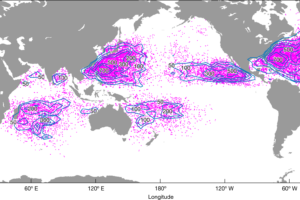In April 2021, a Daily Mail article claiming that Joe Biden planned to limit beef consumption to 4lb a year per person to meet environmental targets went viral. Though it was totally false, it sparked a chorus among rightwingers that Democrats “want to take away your hamburgers”.
For many on the right, beef is a hot-button issue.
The Canadian pop psychologist Jordan Peterson – who’s been called “custodian of the patriarchy” by the New Yorker – is an adherent of carnivore diets. Joe Rogan, more recently in the news for agreeing with the notorious misogynist Andrew Tate, has himself promoted “the Lion Diet”, a carnivore approach that eschews even dairy in favor of water, salt, and meat from ruminant animals. This way of eating has been gaining traction on social media, where shirtless men proudly display their meals of steak, grassfed-cow butter, and duck eggs.
That these men believe in prescribed gender roles and all-American tradition is no coincidence. “Recent scientific studies confirm that those of us who hold authoritarian beliefs … who seek wealth and power and support human dominance over nature, eat more meat than those who stand against inequality,” writes Marta Zaraska in her book Meathooked: The History and Science of Our 2.5-Million-Year Obsession with Meat.
For these men, performative meat eating is a demonstration of virility and restraint; of power and savagery.
These ideas are tied up in the history of beef, something most people in the US grow up believing is an inevitable and undeniable part of our diets, a birthright. This did not happen by accident, and cultural imperialism has played a part in the beef industry since its beginnings.
The cowboy, the enduring symbol of virility, affluence, and rugged Americana, is himself a cattle farmer. Cowboys were responsible for herding cattle in the west from the early 1800s, when English-speaking ranchers adopted the customs of Mexico’s vaqueros, until mechanization took over by the early 20th century. Yet their place in mythology has only grown over time. The figure in US culture represents not just masculinity, control of livestock, and the dominance of the west, but the very genocide upon which the nation was built – which can’t be looked at as separate from the role of meat and military strength in American ideology.
Settler colonialism, the term that describes the displacement of Indigenous peoples in favor of European settlers, was essential to the creation of the beef industry – as it was for many other beloved American institutions. Nineteenth-century government policy saw the Great Plains ecosystem turned from a grass-bison-nomad system to a grass-cattle-rancher one, with the Indian wars a necessary step in the establishment of the rancher mythos.
Bison herds were decimated by settlers who saw them as “monstrous”, while cattle represented civilization, according to Joshua Specht’s book Red Meat Republic: A Hoof-to-Table History of How Beef Changed America. “Cattle ranchers and bison hunters, supported by the US military, fundamentally reshaped the Great Plains,” writes Specht, “expelling American Indians from western lands and appropriating that land for use by white settlers and ranchers.”
Destroying bison herds was part of an attempt to starve Indigenous peoples into submission, as these were a significant part of their livelihoods, and the US army took on an active role in aiding and abetting this process. Without this process of extermination and colonization, beef’s emergence as a staple of the American diet might not have occurred so readily.
The idea that meat is as essential as air has been part of the American project since its inception. But the popularity of beef has been manufactured and created by cultural and market forces.

Beef’s modern market dominance was also manufactured. The meat industry’s marketing campaigns – including 80s and 90s advertising slogans such as “Beef. It’s What’s for Dinner”, spoken by strong male voices – have long been funded by commodity checkoff programs that are paid into by farmers, often to the benefit of massive manufacturers and the detriment of small ones. The federal government’s annual subsidies of meat and animal products amount to $38bn. Eating animal products for breakfast, lunch, and dinner is overconsumption that would have been unthinkable to previous generations, and it has been driven by marketing and industrial farming.
Despite the Daily Mail’s claims, the industry is not under attack – the Democrats’ center-right policies have never dared challenge the industrial meat and dairy’s lobbyists. Biden has no real plans to reduce beef consumption – though it is true that people in the US are eating a little less beef, probably because of bad press regarding greenhouse gas emissions and poor health outcomes. In fact, presidents of both parties have frequently demonstrated that they will stop at nothing to keep not just beef but all meat plentiful. During the Obama presidency, despite gestures toward progressive environment policies, there were pushes to speed up poultry processing, continued antibiotic overuse in factory farm operations, and other issues in the meat industry that went unattended. At the start of the pandemic, Donald Trump declared meat processing “critical infrastructure”, keeping factories open regardless of safety. Between April 2020 and April 2021, nearly 60,000 meatpacking workers became infected with the coronavirus.
The lure of beef is so strong that even as vegetarianism becomes slightly more popular, plant-based replacements do everything they can to look as much like bloody flesh as possible. Often, this seems to give them a free pass to flourish in meat-dominated spaces: the Impossible Burger, for example, launched with chef partnerships, working with people such as David Chang, a previously vocal anti-vegetarian. It is now on menus at Burger Kings, White Castles and Little Caesars.

Impossible Foods’ biggest selling point is its proprietary product, “heme”. Heme, in meat, is in the protein hemoglobin in an animal’s blood or myoglobin in the muscle, which is believed to give hamburgers their color and slightly metallic flavor. In the Impossible Foods version, the DNA of soy plants is inserted into a genetically engineered yeast and then fermented. This results in both the pink color and “blood” of their patties.
“Our relationship to meat is powerful,” Zaraska writes in her book, which explores how meat has long been a status symbol – in gender, class, and even nationalism. If you remove this symbol, you have to make up the difference somehow. When you’re no longer exerting power over animals, it helps to at least look like you could, and to eat food that resembles flesh.
It is telling that this most high-profile strand of the plant-based eating movement has not been able to write new rules but has followed the meat industry’s example. It is designed to be cooked like meat, enabling seamless adoption by fast food restaurants. It’s designed to be packaged and branded like meat, allowing for huge VC funding, akin to the subsidies that make industrial meat so excessively abundant. It all harkens back to the early days of the US meat industry, rather than a rethinking of the American diet. This replication relies on the same cultural ideas and industrial structures, with the new addition of climate considerations.
The beef industry is devastating for the planet – it drives greenhouse gas emissions, deforestation, soil degradation, and excess water usage. Environmentally speaking, the rise of lab-grown meat is better than nothing in the efforts to drive down beef consumption. But there are serious concerns about the impact of tech meat, too: fears that it could lead to similar issues because of monocropping, centralized production, and singular supply chains.
In order to meet environmental targets, the US needs to eat drastically less beef than we are currently consuming. We also need to reverse global trends: many other countries are developing a taste for cheap cow and pork. Global meat consumption is expected to increase by 1.4% this year, which is more than the planet can handle. But as a society we are unable to tackle our meat consumption without acknowledging that beef is more than a foodstuff – when it means cowboys, masculinity and strength, when it is a literal cash cow for so many, when so many in the US are committed to its significance – and when even the newfangled substitutes are hooked on the old models of how meat should be sold and what it looks like.
Last month the beef board launched a new campaign called “together we bring more”. It promised a “storytelling approach” so that “consumers can learn more about what beef means to them and share their own stories” with a giant advertising campaign to run during baseball games. Clearly they know that beef, for Americans, is about more than what’s in your burger.
Source : The Guardian












Add Comment